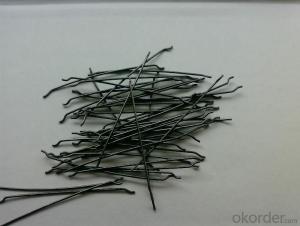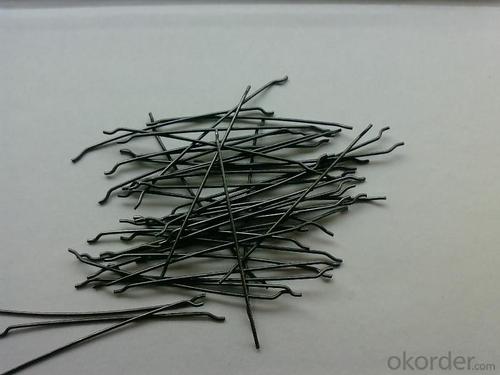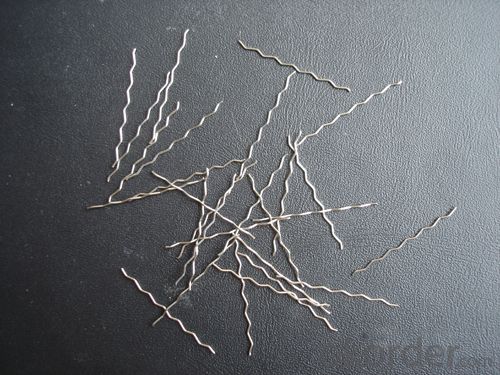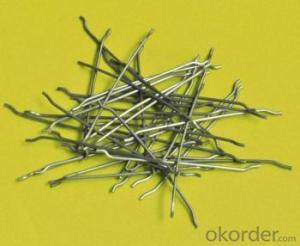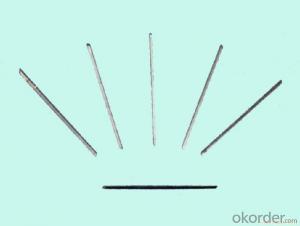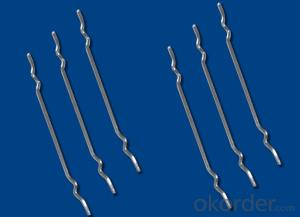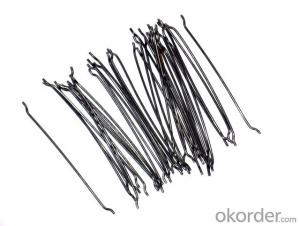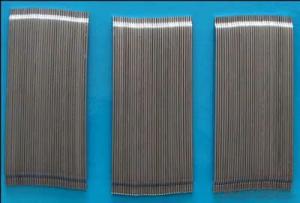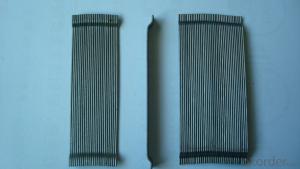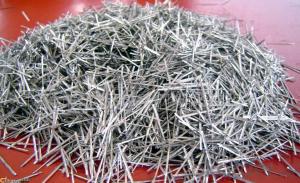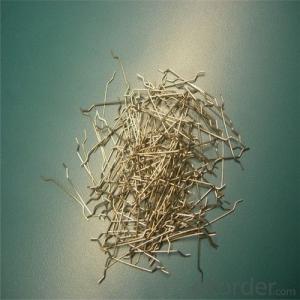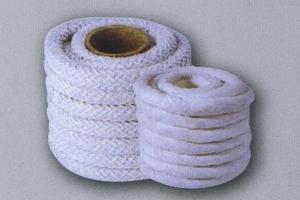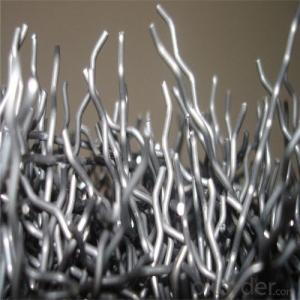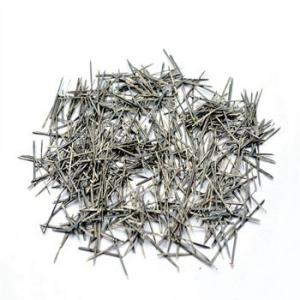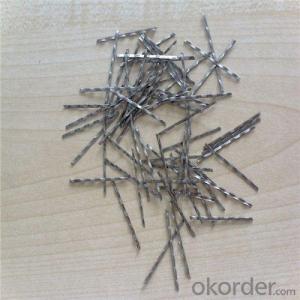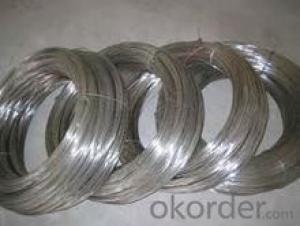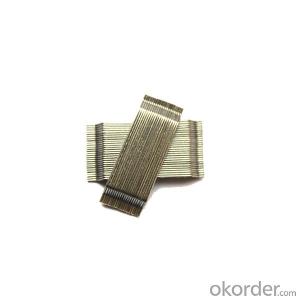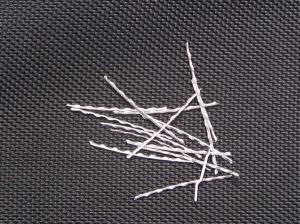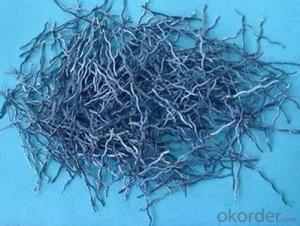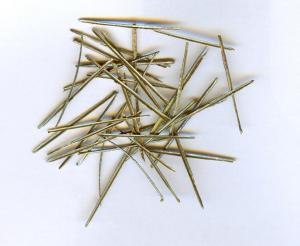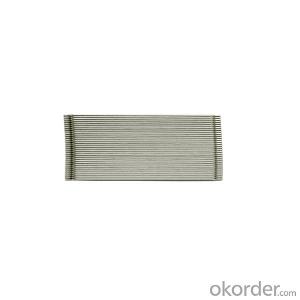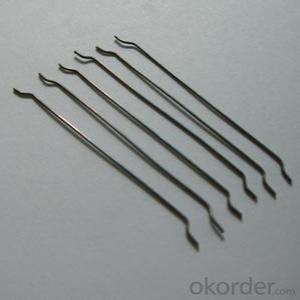Steel Fiber Cold drawn wire for Refractories Materials
- Loading Port:
- Tianjin
- Payment Terms:
- TT OR LC
- Min Order Qty:
- 5000 kg
- Supply Capability:
- 200000 kg/month
OKorder Service Pledge
OKorder Financial Service
You Might Also Like
Quick Details
Place of Origin: Shandong, China (Mainland)
Model Number: 38/40
Material: High quality low carbon steel
Tensile Strength: Min 700Mpa
Product features
Flat crimped steel fiber are manufactured by milling steel ingots. Compared with other steel fibers, its tensile strength is a little lower, about 600Mpa.
To achieve the same performance, the percentage of steel fibers should increases.
Specifications
Flat Crimped steel fiber | ||||
Type | Length(mm) | Tensile strength | ||
LB-30 | 30 | >=600Mpa | ||
LB-32 | 32 | >=600Mpa | ||
LB-35 | 35 | >=600Mpa | ||
Perform our country YB/T151-1999 "the concrete uses steel fibre " black metallurgy industry standard;
the JG/T3064-1999 steel fibre concrete building industry industry standard and ASTM A820 "Steel Fibres for Fibre-Reinforced Concrete"
Picture
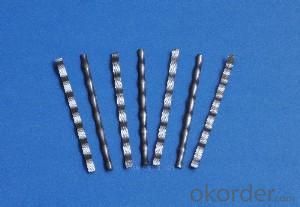
Easy-to-use
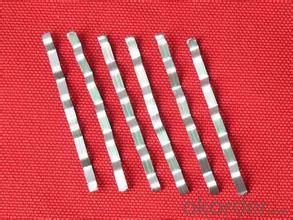
significantly increase impact, shatter and abrasion resistance;
Easy-to-use;
Extend durability and fatigue resistance;
Shotcrete, tunnel linings.
Mass concrete composite deck construction.
Precast concrete.
Industrial slabs on ground.
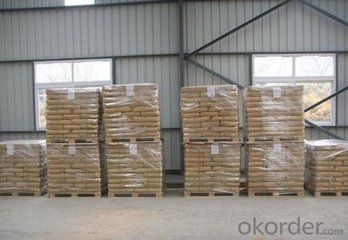
FAQ
we can produce any type steel fiber and of course we can make production according to your requirement
we have specilize in this field for almost 10 years ,with good quality and competitive price
To achieve the same performance, the percentage of steel fibers should increases.
- Q: Can melt extract stainless steel fiber be used in airport runways or taxiways?
- Yes, melt extract stainless steel fiber can be used in airport runways or taxiways. The use of stainless steel fibers in these areas provides numerous benefits. Firstly, the addition of stainless steel fibers enhances the overall strength and durability of the concrete used in constructing runways and taxiways. This increased strength helps to prevent cracking and deterioration caused by heavy aircraft traffic and extreme weather conditions. Furthermore, the use of stainless steel fibers can improve the resistance of the concrete to fatigue and abrasion, ensuring a longer lifespan for the runway or taxiway. This is particularly important in airport environments where constant heavy traffic and the presence of debris can cause wear and tear over time. Additionally, stainless steel fibers offer excellent resistance to corrosion, which is crucial in airport settings where de-icing agents and other chemicals are frequently used. By incorporating stainless steel fibers into the concrete mix, the runway or taxiway can withstand exposure to these corrosive substances, reducing the need for frequent maintenance and repairs. In summary, melt extract stainless steel fiber is a suitable material for airport runways and taxiways due to its ability to enhance the strength, durability, fatigue resistance, and corrosion resistance of the concrete used in their construction.
- Q: Can melt extract stainless steel fiber be used in fiber-reinforced polymer (FRP) composites?
- Yes, melt extract stainless steel fiber can be used in fiber-reinforced polymer (FRP) composites. Melt extract stainless steel fiber is an ideal reinforcement material due to its high strength and corrosion resistance properties. It can enhance the mechanical properties of FRP composites, such as increasing their strength, stiffness, and impact resistance. Additionally, the addition of stainless steel fiber can improve the durability and fire resistance of FRP composites. Overall, melt extract stainless steel fiber is a suitable choice for reinforcing FRP composites, making them more robust and suitable for various applications in industries such as construction, automotive, and aerospace.
- Q: Does melt extract stainless steel fiber have a high resistance to corrosion?
- Melt extract stainless steel fiber displays a remarkable resistance to corrosion. The outstanding corrosion resistance of stainless steel stems from the inclusion of chromium in its composition, resulting in the formation of a protective oxide layer on the steel's surface. This oxide layer acts as a barrier, preventing the steel from encountering corrosive substances and thereby augmenting its corrosion resistance. The production of melt extract stainless steel fibers involves a process known as melt extraction, which ensures that the fibers retain the desirable attributes of stainless steel, including its resistance to corrosion. Consequently, melt extract stainless steel fibers exhibit an exceptional resistance to corrosion, rendering them suitable for implementation in demanding environments, such as those found in marine, chemical, and industrial settings.
- Q: What is the effect of melt extract stainless steel fiber on the modulus of creep of concrete?
- The inclusion of melt extract stainless steel fibers in concrete has a positive effect on the modulus of creep of the material. Stainless steel fibers are known for their high tensile strength, corrosion resistance, and durability. When these fibers are added to concrete, they act as reinforcement, enhancing its overall mechanical properties. The modulus of creep refers to the material's ability to resist deformation over time under a constant load. By adding stainless steel fibers, the concrete's resistance to creep is improved, as the fibers help to distribute the load and reduce internal stresses within the material. This leads to a decrease in the rate of creep and a higher modulus of creep. The presence of melt extract stainless steel fibers also enhances the overall ductility of the concrete. This means that the material can withstand greater deformation before failure, resulting in improved structural stability and performance. This is particularly beneficial in applications where the concrete is subjected to sustained loads or temperature variations, as it reduces the risk of long-term deformation and potential structural failure. Overall, the effect of melt extract stainless steel fibers on the modulus of creep of concrete is a positive one. Their addition improves the material's resistance to deformation over time, enhances its mechanical properties, and increases its overall durability.
- Q: What is the effect of melt extract stainless steel fiber on the modulus of deformation of concrete?
- The addition of melt extract stainless steel fiber to concrete can have a positive effect on the modulus of deformation. Stainless steel fibers are known for their high tensile strength and ductility, which allows them to increase the overall strength and flexibility of concrete structures. When mixed into concrete, these fibers create a three-dimensional reinforcement network, distributing stresses more evenly throughout the material. This helps to reduce cracking and improve the overall durability of the concrete. The presence of stainless steel fibers also improves the modulus of deformation of concrete. The modulus of deformation is a measure of how much a material deforms under stress. By reinforcing the concrete, stainless steel fibers help to restrict excessive deformation and improve its ability to withstand external loads. Furthermore, the addition of stainless steel fibers can increase the post-cracking behavior of concrete, meaning that even after the concrete cracks, it can still maintain its structural integrity and load-bearing capacity. Overall, the incorporation of melt extract stainless steel fiber in concrete enhances its modulus of deformation, increasing its strength, flexibility, and resistance to cracking. This can lead to improved performance and longevity of concrete structures.
- Q: What is the effect of melt extract stainless steel fiber on the plastic settlement of shotcrete?
- The effect of melt extract stainless steel fiber on the plastic settlement of shotcrete is significant. The addition of melt extract stainless steel fibers to shotcrete helps to improve its overall performance and reduce plastic settlement. Shotcrete is commonly used in construction for its ability to be applied quickly and efficiently. However, one of the challenges with shotcrete is plastic settlement, which refers to the settling or sinking of the material before it sets and hardens. This settlement can lead to cracks, voids, and reduced strength in the shotcrete. Melt extract stainless steel fibers are specifically designed to address this issue. These fibers are added to the shotcrete mix, and during the application process, they disperse uniformly throughout the material. As the shotcrete settles, the stainless steel fibers act as reinforcement, providing additional support and preventing excessive settlement. The stainless steel fibers enhance the tensile strength of the shotcrete, making it more resistant to cracking and deformation. They create a three-dimensional network within the material, increasing its overall structural integrity. This reinforcement effect significantly reduces the plastic settlement of shotcrete, ensuring that it retains its shape and strength during the setting process. Furthermore, melt extract stainless steel fibers also improve the durability and longevity of shotcrete. They help to prevent the formation of shrinkage cracks and provide added protection against external factors such as temperature changes, moisture, and chemical exposure. In summary, the addition of melt extract stainless steel fibers to shotcrete has a positive effect on its plastic settlement. These fibers reinforce the material, reduce settlement, and improve its overall performance, durability, and strength.
- Q: How does the addition of melt extract stainless steel fiber affect the toughness of concrete?
- The addition of melt extract stainless steel fiber significantly enhances the toughness of concrete. These fibers act as reinforcement within the concrete matrix, increasing its resistance to cracking and improving its overall durability. The stainless steel fibers help to distribute stress and absorb energy, resulting in a more robust and resilient concrete structure.
- Q: Does melt extract stainless steel fiber enhance the bond strength between concrete layers?
- The inclusion of melt extract stainless steel fiber indeed heightens the bond strength between layers of concrete. By incorporating stainless steel fibers into concrete mixtures, the mechanical properties, specifically the bond strength between layers, are enhanced. As the concrete solidifies, the stainless steel fibers disperse evenly throughout the mixture, reinforcing it and augmenting the overall strength. This reinforcement fortifies the bond between layers, rendering it more resilient against cracking, delamination, and other forms of failure. Additionally, the integration of melt extract stainless steel fibers can enhance the durability and longevity of the concrete structure by diminishing the risk of spalling and increasing its resistance to impacts and vibrations. Ultimately, the utilization of melt extract stainless steel fiber in concrete significantly improves the bond strength between layers, elevating the performance and lifespan of the concrete structure.
- Q: Can melt extract stainless steel fiber be used in concrete pavement overlays?
- Yes, melt extract stainless steel fiber can be used in concrete pavement overlays.
- Q: How does melt extract stainless steel fiber impact the load transfer between concrete layers?
- Melt extract stainless steel fibers enhance load transfer between concrete layers by improving the bond strength and overall mechanical properties of the concrete. These fibers act as reinforcement, dispersing stress and preventing crack propagation, thereby increasing the load-carrying capacity and durability of the concrete structure.
Send your message to us
Steel Fiber Cold drawn wire for Refractories Materials
- Loading Port:
- Tianjin
- Payment Terms:
- TT OR LC
- Min Order Qty:
- 5000 kg
- Supply Capability:
- 200000 kg/month
OKorder Service Pledge
OKorder Financial Service
Similar products
Hot products
Hot Searches
Related keywords
